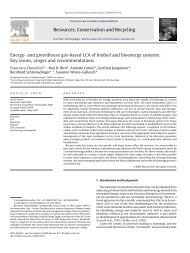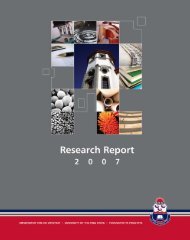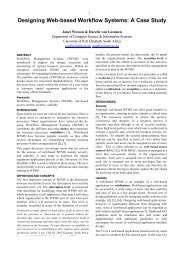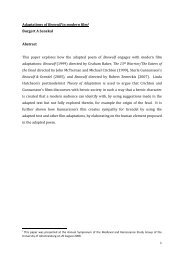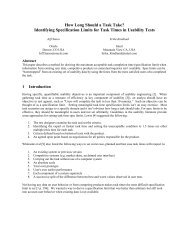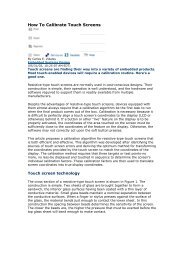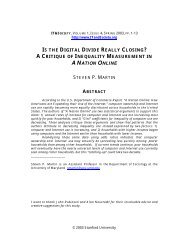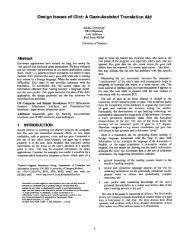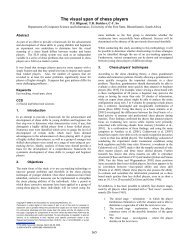Computer self efficacy, computer anxiety, attitudes towards the ...
Computer self efficacy, computer anxiety, attitudes towards the ...
Computer self efficacy, computer anxiety, attitudes towards the ...
Create successful ePaper yourself
Turn your PDF publications into a flip-book with our unique Google optimized e-Paper software.
534 A. Durndell, Z. Haag / <strong>Computer</strong>s in Human Behavior 18 (2002) 521–535Bandura, A. (1997). The exercise of control. New York: W. H. Freeman.Beckers, J., & Schmidt, H. (2001). The structure of <strong>computer</strong> <strong>anxiety</strong>: a six factor model. <strong>Computer</strong>s inHuman Behavior, 17(1), 35–49.Brosnan, M. (1998). Technophobia. London: Routledge.Brosnan, M., & Lee, W. (1998). A cross cultural comparison of gender differences in <strong>computer</strong> <strong>attitudes</strong>and <strong>anxiety</strong>: <strong>the</strong> UK and Hong Kong. <strong>Computer</strong>s in Human Behavior, 14(4), 559–577.Buckley, M. (1989). Women and ideology in <strong>the</strong> Soviet Union. Hemel Hempstead, England: HarvesterWheatsheaf.Chua, S., Chen, D., & Wong, P. (1999). <strong>Computer</strong> <strong>anxiety</strong> and its correlates: a meta analysis. <strong>Computer</strong>sin Human Behavior, 15(5), 609–623.Coffin, R., & Mackintyre, P. (2000). Cognitive, motivation and affective processes associated with <strong>computer</strong>related performance: a path analysis. <strong>Computer</strong>s in Human Behavior, 16(2), 199–222.Colley, A., Gale, M., & Harris, T. (1994). Effects of gender role identity and experience on <strong>computer</strong>attitude components. Journal of Educational Computing Research, 10(2), 129–137.Durndell, A. (1991). Paradox and practice: gender in computing and engineering in eastern Europe. InG. Lovegrove, & B. Segal (Eds.), Women into computing: selected papers 1988–1990 (pp. 392–400).London: Springer Verlag.Durndell, A., Cameron, C., Knox, A., Stocks, R., & Haag, Z. (1997). Gender and computing: west andeast Europe. <strong>Computer</strong>s in Human Behavior, 13(2), 269–280.Durndell, A., Haag, Z., & Laithwaite, H. (2000). <strong>Computer</strong> <strong>self</strong> <strong>efficacy</strong> and gender: a cross cultural studyof Scotland and Romania. Personality and Individual Differences, 28, 1037–1044.Durndell, A., & Thomson, K. (1997). Gender and computing: a decade of change? <strong>Computer</strong>s and Education,28(1), 1–9.Durndell, A., Uzunova, F., Asenova, D., Asenov, A., & Thomson, K. (1998). Gender neutral engineering:an impossible dream?—<strong>the</strong> case of east Europe. International Journal of Science Education, 20(7), 783–793.Farenga, S., & Joyce, B. (1999). Intentions of young students to enrol in science courses in <strong>the</strong> future: anexamination of gender differences. Science Education, 83(1), 55–75.Gackenbach, J. (Ed.). (1998). Psychology and <strong>the</strong> Internet: intrapersonal, interpersonal and transpersonalimplications. New York: Academic Press.Griffiths, M. (1999). Internet addiction. The Psychologist, 12(5), 246–250.Grundy, F. (1996). Women and <strong>computer</strong>s. Exeter, England: Intellect Books.Heinssen, R. K., Glass, C. R., & Knight, L. A. (1987). Assessing <strong>computer</strong> <strong>anxiety</strong>: development andvalidation of <strong>the</strong> <strong>computer</strong> <strong>anxiety</strong> rating scale. <strong>Computer</strong>s in Human Behavior, 3, 49–59.HESA (Higher Education Statistics Agency) (2000). Higher education statistics for <strong>the</strong> UK, 1998/9. London:HESA.Holdstock, L. (1989). The ratio of male to female undergraduates. In J. Radford (Ed.), Gender and choicein education and occupation (pp. 59–83). London: Routledge.Kraut, R., Patterson, M., Lundmark, V., Kiesler, S., Mukopadhyay, T., & Scherlis, W. (1989). Internetparadox: a social technology that reduces social involvement and psychological well-being? AmericanPsychologist, 53(9), 1017–1031.Levine, T., & Donitsa-Schmidt, S. (1998). <strong>Computer</strong> use, confidence, <strong>attitudes</strong> and knowledge: a causalanalysis. <strong>Computer</strong>s in Human Behavior, 14(1), 125–146.Maurer, M. (1994). <strong>Computer</strong> <strong>anxiety</strong> correlates and what <strong>the</strong>y tell us: a literature review. <strong>Computer</strong>s inHuman Behavior, 10(3), 369–376.McIlroy, D., Bunting, B., Tierney, K., & Gordon, M. (2001). The relation of gender and backgroundexperience to <strong>self</strong> reported computing <strong>anxiety</strong> and cognitions. <strong>Computer</strong>s in Human Behavior, 17(1),21–33.Miller, J., & Durndell, A. (2001). Internet use, <strong>computer</strong> <strong>anxiety</strong> and <strong>attitudes</strong> <strong>towards</strong> <strong>the</strong> Internet: acomparison of <strong>the</strong> USA and Scotland. Proceedings of <strong>the</strong> British Psychological Society, 9(2), 108.Morahan-Martin, J. (1998). Males, females and <strong>the</strong> Internet. In J. Gackenbach (Ed.), Psychology and <strong>the</strong>Internet: intrapersonal, interpersonal and transpersonal implications (pp. 169–184). New York: AcademicPress.



